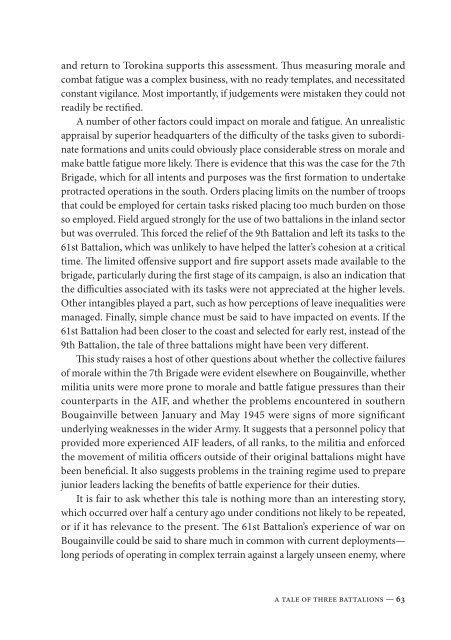View the pdf - Australian Army
View the pdf - Australian Army
View the pdf - Australian Army
Create successful ePaper yourself
Turn your PDF publications into a flip-book with our unique Google optimized e-Paper software.
and return to Torokina supports this assessment. Thus measuring morale andcombat fatigue was a complex business, with no ready templates, and necessitatedconstant vigilance. Most importantly, if judgements were mistaken <strong>the</strong>y could notreadily be rectified.A number of o<strong>the</strong>r factors could impact on morale and fatigue. An unrealisticappraisal by superior headquarters of <strong>the</strong> difficulty of <strong>the</strong> tasks given to subordinateformations and units could obviously place considerable stress on morale andmake battle fatigue more likely. There is evidence that this was <strong>the</strong> case for <strong>the</strong> 7thBrigade, which for all intents and purposes was <strong>the</strong> first formation to undertakeprotracted operations in <strong>the</strong> south. Orders placing limits on <strong>the</strong> number of troopsthat could be employed for certain tasks risked placing too much burden on thoseso employed. Field argued strongly for <strong>the</strong> use of two battalions in <strong>the</strong> inland sectorbut was overruled. This forced <strong>the</strong> relief of <strong>the</strong> 9th Battalion and left its tasks to <strong>the</strong>61st Battalion, which was unlikely to have helped <strong>the</strong> latter’s cohesion at a criticaltime. The limited offensive support and fire support assets made available to <strong>the</strong>brigade, particularly during <strong>the</strong> first stage of its campaign, is also an indication that<strong>the</strong> difficulties associated with its tasks were not appreciated at <strong>the</strong> higher levels.O<strong>the</strong>r intangibles played a part, such as how perceptions of leave inequalities weremanaged. Finally, simple chance must be said to have impacted on events. If <strong>the</strong>61st Battalion had been closer to <strong>the</strong> coast and selected for early rest, instead of <strong>the</strong>9th Battalion, <strong>the</strong> tale of three battalions might have been very different.This study raises a host of o<strong>the</strong>r questions about whe<strong>the</strong>r <strong>the</strong> collective failuresof morale within <strong>the</strong> 7th Brigade were evident elsewhere on Bougainville, whe<strong>the</strong>rmilitia units were more prone to morale and battle fatigue pressures than <strong>the</strong>ircounterparts in <strong>the</strong> AIF, and whe<strong>the</strong>r <strong>the</strong> problems encountered in sou<strong>the</strong>rnBougainville between January and May 1945 were signs of more significantunderlying weaknesses in <strong>the</strong> wider <strong>Army</strong>. It suggests that a personnel policy thatprovided more experienced AIF leaders, of all ranks, to <strong>the</strong> militia and enforced<strong>the</strong> movement of militia officers outside of <strong>the</strong>ir original battalions might havebeen beneficial. It also suggests problems in <strong>the</strong> training regime used to preparejunior leaders lacking <strong>the</strong> benefits of battle experience for <strong>the</strong>ir duties.It is fair to ask whe<strong>the</strong>r this tale is nothing more than an interesting story,which occurred over half a century ago under conditions not likely to be repeated,or if it has relevance to <strong>the</strong> present. The 61st Battalion’s experience of war onBougainville could be said to share much in common with current deployments—long periods of operating in complex terrain against a largely unseen enemy, whereA tale of three battalions — 63
















